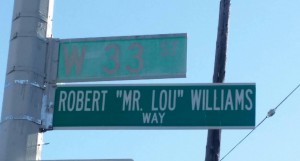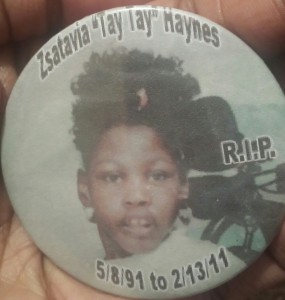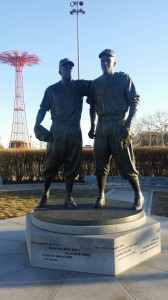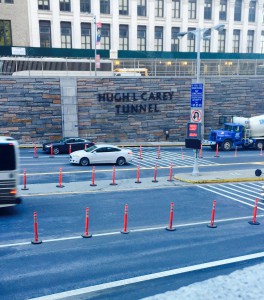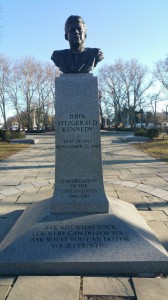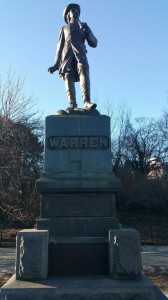
This picture was taken from the oval plaza and entryway to Prospect Plaza at the Grand Army Plaza in Brooklyn, NY. It is of Union Army general Gouverneur Kemble Warren (1830-1882). He was honored for his bravery before and during the Civil War.
This was well deserved and shows great dedication towards one’s country.
http://www.nycgovparks.org/parks/grand-army-plaza/monuments/1648
This sculpture by Henry Baerer (1837–1908) honors the distinguished Union Army general Gouverneur Kemble Warren (1830–1882). It is one of three Civil War monuments that grace this oval plaza and entryway to Prospect Park, which was first laid out in the 1860s and dedicated in 1926 to the Grand Army of the Republic (the Union Army in the Civil War).
General Warren was born in Cold Spring, in Putnam County, New York. He graduated from the United States Military Academy at West Point in 1850. Before the Civil War, he helped the Army Corps of Engineers survey areas west of Mississippi, oversaw rapids and canal improvements, and taught mathematics at West Point.
Warren was named Lieutenant Colonel of the Fifth Regiment in New York in 1861, and fought at Big Bethel, Virginia. Later, as Captain, he led the Yorktown siege of 1862, and was engaged in combat at Malvern Hill, Harrison’s Landing, Second Bull Run, Antietam, Centreville, and Fredericksburg. He was appointed Brigadier General in September 1862, and named Chief Topographical Engineer of the Army of the Potomac in 1863. At the famous battle of Gettysburg in 1863, he was wounded at Little Round Top, and a monument was later placed there to commemorate his valor.
Warren subsequently served as the chief engineer and the commanding officer at numerous battle sites, though his actions were questioned at Five Forks in Virginia. One account said Warren “made victory decisive there,” but General Philip Sheridan, feeling that Warren was negligent in his duties, relieved him of his station. Though a court of inquiry exonerated Warren of Sheridan’s charges 14 years after the war, Warren was said have been broken personally and ruined professionally. Warren remained in the armed services as a Lieutenant Colonel of Engineers until he died in Newport, Rhode Island on August 8, 1882.
Sculptor Henry Baerer was born in Kirscheim, Germany, and came to the United States in 1854. He was especially well-known as a portrait sculptor, and contributed six sculptures to the parks of New York City, including statues of composer Ludwig van Beethoven in Prospect and Central Parks, and a bust of industrialist Conrad Poppenhusen (1818-1883) in College Point, Queens.
In 1938, the city monuments crew cleaned and repatined the sculpture and bronze tablet set within its base. Having since suffered more than 60 years of exposure to the elements, the sculpture was conserved in 2001.
The American soldier Gouverneur Kemble Warren was born at Coldspring, New York, on the 8th of January 1830, and entered West Point in 1846, graduating in 1850. He was assigned to the engineers, and for several years was employed in survey work in the West, where he took part in some expeditions against the Indians. In 1859 he was made assistant instructor in mathematics at West Point. But two years later, at the outbreak of the Civil War, the scientific subaltern was made lieutenant-colonel of volunteers and posted to the newly raised 5th New York Volunteer Infantry. He was fully equal to the task, for his regiment was very soon brought into a state of marked efficiency. In August he was promoted colonel. He commanded a brigade of the V. corps at Gaines’s Mill, Second Bull Run and Antietam, and was shortly afterwards promoted brigadier-general of Volunteers. During the Fredericksburg campaign he was on the engineer staff of the Army of the Potomac, but after Chancellorsville he was appointed chief of engineers in that army, and in that capacity rendered brilliant services at Gettysburg, his reward being promotion to major-general U.S.V. and the brevet of colonel in the regular army. When the Army of the Potomac was reorganized in the spring of 1864 Warren returned to the V. corps as its commander.
His services in the Wilderness and Petersburg campaigns proved his fitness for this large and responsible command, but his naturally lively imagination and the engineer’s inbred habit of caution combined to make him a brilliant but somewhat unsafe subordinate. He would have become one of the great chiefs of staff of history, or even a successful army commander, but he sometimes failed where a less highly gifted man would have succeeded. He was at his best when the military situation depended on his exercising his initiative, as on the first day in the Wilderness, in which his action saved the army, at his worst when, as on the 10th of May before Spottsylvania, he was ordered to attempt the impossible. On the latter occasion bothUlysses S. Grant and George Gordon Meade threatened to relieve him of his command, and Humphreys, the chief of staff of the army, was actually sent to control the movements of the V. corps.
http://www.nndb.com/people/516/000050366/




